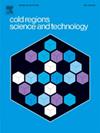冻融破坏程度及其对砂岩剪切强度参数影响的研究
IF 3.8
2区 工程技术
Q1 ENGINEERING, CIVIL
引用次数: 0
摘要
在以往的研究中,剪切强度参数随冻融循环的变化并不十分清楚。本研究主要探讨了冻融处理对砂岩剪切强度参数的影响及其与冻融破坏变量的关系。在冻融循环下,砂岩表面的分数尺寸和基本摩擦角呈上升趋势。这意味着,由于冻融损失了胶结矿物,砂岩表面变得更加粗糙,从而导致基本摩擦角增大。另一个有趣的发现是,虽然砂岩的内聚力降低了,但内摩擦角也随着冻融循环的增加而增大。因此,冻融作用下剪切强度的降低应归因于内聚力的丧失。此外,抗剪强度参数的变化还与冻融破坏程度有关。随着冻融循环次数的增加,孔隙度较高的 YY 和 YR 砂岩的孔隙度增加和 P 波速度降低的幅度更大,因此其遭受的冻融破坏更为严重,剪切强度参数的变化也更大。新发现是基本摩擦角的增长与冻融破坏的增加呈正相关,内摩擦角随着冻融破坏的增加呈指数增长。这项研究有助于更好地理解冻融循环下剪切强度参数的变化。本文章由计算机程序翻译,如有差异,请以英文原文为准。
Study on the freeze-thaw damage degree and its influence on the shear strength parameters of sandstones
The variations of shear strength parameters against the freeze-thaw cycles are not well understood in the previous study. This research mainly investigated the influence of freeze-thaw treatment on the shear strength parameters and their relationship with the freeze-thaw damage variable for sandstones. The fraction dimensions of sandstone surfaces and basic friction angles display an increasing trend under freeze-thaw cycles. It implies that the sandstone surface becomes rougher due to the freeze-thaw loss of cementation minerals and thus induces the increase in the basic friction angle. Another interesting finding is that although the cohesion of sandstone reduces, the internal friction angle also increases with increasing freeze-thaw cycles. Thus, the reduction in the shear strength under freeze-thaw actions should be attributed to the loss of cohesion. Moreover, the change of shear strength parameters is also related with the freeze-thaw damage degree. As the number of freeze-thaw cycles increases, the increase in porosity and reduction in P-wave velocity are much larger for the YY and YR sandstones with higher porosities, thus, they suffer much more serious freeze-thaw damage, and they have a much larger variation in shear strength parameters. The novel finding is that the growth in basic friction angle is positively correlated with the increase of freeze-thaw damage, and the internal friction angle exponentially increases with the increase of freeze-thaw damage. This study provides a much better understanding of the change of the shear strength parameters under freeze-thaw cycles.
求助全文
通过发布文献求助,成功后即可免费获取论文全文。
去求助
来源期刊

Cold Regions Science and Technology
工程技术-地球科学综合
CiteScore
7.40
自引率
12.20%
发文量
209
审稿时长
4.9 months
期刊介绍:
Cold Regions Science and Technology is an international journal dealing with the science and technical problems of cold environments in both the polar regions and more temperate locations. It includes fundamental aspects of cryospheric sciences which have applications for cold regions problems as well as engineering topics which relate to the cryosphere.
Emphasis is given to applied science with broad coverage of the physical and mechanical aspects of ice (including glaciers and sea ice), snow and snow avalanches, ice-water systems, ice-bonded soils and permafrost.
Relevant aspects of Earth science, materials science, offshore and river ice engineering are also of primary interest. These include icing of ships and structures as well as trafficability in cold environments. Technological advances for cold regions in research, development, and engineering practice are relevant to the journal. Theoretical papers must include a detailed discussion of the potential application of the theory to address cold regions problems. The journal serves a wide range of specialists, providing a medium for interdisciplinary communication and a convenient source of reference.
 求助内容:
求助内容: 应助结果提醒方式:
应助结果提醒方式:


